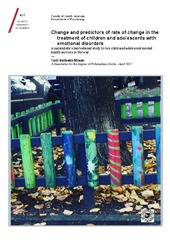Change and predictors of rate of change in the treatment of children and adolescents with emotional disorders: A naturalistic observational study in two child and adolescent mental health services in Norway
Permanent link
https://hdl.handle.net/10037/11076View/
Thesis (PDF)
Paper 3: Nilsen, T. S., Handegard, B. H., Eisemann, M., Kvernmo, S.: “Predictors of rate of change for children and youth with emotional disorders: a naturalistic observational study”. Also available in Child and Adolescent Psychiatry and Mental Health 2016, 10:11-11. (PDF)
Date
2017-05-15Type
Doctoral thesisDoktorgradsavhandling
Author
Nilsen, Toril SørheimAbstract
The goals of this dissertation was to evaluate the rate of change, and associations between demographic and clinical characteristics and rate of change, for children and adolescents with anxiety and/or depression that had been treated within two Child and Adolescent Mental Health Services (CAMHS) in the North of Norway. The study was of naturalistic observational type. Data from clinical instruments were collected as part of ordinary clinical practice. The study sample consisted of 84 children and youth with emotional disorders. The Strengths and Difficulties Questionnaire (SDQ), the Health of the Nation Outcome Scale (HONOSCA) and the Children’s Global Assessment Scale (CGAS) were used as measures of change. A literature review (paper 1) showed that none of the pre-treatment demographic variables, such as age, gender and ethnic background, were found to consistently predict or moderate treatment outcome. Higher levels of baseline symptomatic severity were associated with worse outcome in depression treatment studies. Paper 2 show a statistically significant improvement per month during outpatient treatment according to nearly all the measures of change, that change rates during active assessment/treatment were larger than during the waitlist period for the clinician-rated scores, and that only a small proportion of the subjects had change scores that were statistically reliable and clinically significant. Paper 3 showed that children and adolescents with a diagnosis of depression had statistically significantly higher symptom severity levels at baseline and significantly lower change rates as compared to youths with an anxiety disorder. No other variables were associated with differences in rate of change. In sum, the results of these studies point to the importance of tracking change during CAMHS treatment and to study change through different approaches and from the viewpoint of different informants. Focusing on prognostic factors for change during CAMHS service provision is also an important further venue.
Description
The papers 1 and 2 of this thesis are not available in Munin.
Paper 1: Nilsen, T. S., Eisemann, M., Kvernmo, S.: “Predictors and moderators of outcome in child and adolescent anxiety and depression: a systematic review of psychological treatment studies”. Available in European Child and Adolescent Psychiatry 2013, 22:69-87.
Paper 2: Nilsen, T. S., Handegård, B. H., Eisemann, M., Kvernmo, S.: “Evaluating change in symptomatic and functional level of children and youth with emotional disorders: a naturalistic observation study”. Available in European Child and Adolescent Psychiatry 2015, 24:1219-1231.
Publisher
UiT The Arctic University of NorwayUiT Norges arktiske universitet
Metadata
Show full item recordCollections
Copyright 2017 The Author(s)
The following license file are associated with this item:


 English
English norsk
norsk
